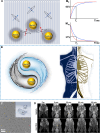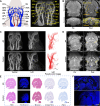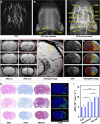Shine and darkle the blood vessels: Multiparameter hypersensitive MR angiography for diagnosis of panvascular diseases
- PMID: 39365870
- PMCID: PMC11451532
- DOI: 10.1126/sciadv.adq4082
Shine and darkle the blood vessels: Multiparameter hypersensitive MR angiography for diagnosis of panvascular diseases
Abstract
Magnetic resonance angiography (MRA) is pivotal for diagnosing panvascular diseases. However, single-modality MRA falls short in diagnosing diverse vascular abnormalities. Thus, contrast agents combining T1 and T2 effects are sought for multiparameter MRA with clinical promise, yet achieving a balance in T1 and T2 contrast enhancement effects remains a scientific challenge. Herein, we developed a hypersensitive multiparameter MRA strategy using dual-modality NaGdF4 nanoparticles. Because of the longer tumbling time (τR), NaGdF4 nanoparticles can improve the longitudinal relaxivity (r1), brightening vessels in T1-weighted sequences. Simultaneously, the regular arrangement of Gd3+ in the crystal induces magnetic anisotropy, creating local static magnetic field heterogeneity and generating negative signals in T2-weighted sequences. Consequently, the efficacy of NaGdF4-enhanced high-resolution multiparameter MRA has been validated in diagnosing ischemic stroke and Alzheimer's disease in rodent models. In addition, the dual-contrast imaging has been realized on swine with a clinical 3.0-T magnetic resonance imaging scanner, highly emphasizing the clinical translation prospect.
Figures








Similar articles
-
Delayed Magnetic Resonance Imaging of Alzheimer's Disease by Using Poly(2-(methacryloyloxy)ethyl phosphorylcholine)-Functionalized Nanoprobes.ACS Appl Mater Interfaces. 2024 Dec 18;16(50):69045-69054. doi: 10.1021/acsami.4c17432. Epub 2024 Dec 5. ACS Appl Mater Interfaces. 2024. PMID: 39636675
-
High relaxivity Gd3+-based organic nanoparticles for efficient magnetic resonance angiography.J Nanobiotechnology. 2022 Mar 31;20(1):170. doi: 10.1186/s12951-022-01363-3. J Nanobiotechnology. 2022. PMID: 35361219 Free PMC article.
-
Evaluating size-dependent relaxivity of PEGylated-USPIOs to develop gadolinium-free T1 contrast agents for vascular imaging.J Biomed Mater Res A. 2018 Sep;106(9):2440-2447. doi: 10.1002/jbm.a.36438. J Biomed Mater Res A. 2018. PMID: 29664208
-
High relaxivity contrast agents in MR angiography of the carotid arteries.Eur Radiol. 2006 Nov;16 Suppl 7:M27-34. doi: 10.1007/s10406-006-0193-2. Eur Radiol. 2006. PMID: 18655264 Review.
-
Contrast-enhanced magnetic resonance angiography: development and optimization of techniques for paramagnetic and hyperpolarized contrast media.Acta Radiol Suppl. 2003 Jul;429:1-30. doi: 10.1034/j.1600-0455.44.s.429.1.x. Acta Radiol Suppl. 2003. PMID: 12757468 Review.
Cited by
-
Shedding light on vascular imaging: the revolutionary role of nanotechnology.J Nanobiotechnology. 2024 Dec 18;22(1):757. doi: 10.1186/s12951-024-03042-x. J Nanobiotechnology. 2024. PMID: 39695727 Free PMC article. Review.
References
-
- Suowen X., Iqra I., Peter J. L., Hong L., Danielle K., Xueying Z., Sihui L., Zhuoming L., Peiqing L., Jihong H., Ian C. H., Eno E. E., Scott J. C., Alastair G. S., Jianping W., Endothelial dysfunction in atherosclerotic cardiovascular diseases and beyond: From mechanism to pharmacotherapies. Pharmacol. Rev. 73, 924–967 (2021). - PubMed
-
- Hu Y., Zhao Y., Li P., Lu H., Li H., Ge J., Hypoxia and panvascular diseases: Exploring the role of hypoxia-inducible factors in vascular smooth muscle cells under panvascular pathologies. Sci. Bull. 68, 1954–1974 (2023). - PubMed
-
- Musialek P., Montauk L., Saugnet A., Micari A., Hopkins L. N., The cardio-vascular future of panvascular medicine: The basics. Kardiol. Pol. 77, 899–901 (2019). - PubMed
-
- Guthaner D. F., Wexler L., Enzmann D. R., Riederer S. J., Keyes G. S., Collins W. F., Brody W. R., Evaluation of peripheral vascular disease using digital subtraction angiography. Radiology 147, 393–398 (1983). - PubMed
-
- Singh A., Mor-Avi V., Patel A. R., The role of computed tomography myocardial perfusion imaging in clinical practice. J. Cardiovasc. Comput. 14, 185–194 (2020). - PubMed
MeSH terms
Substances
LinkOut - more resources
Full Text Sources

